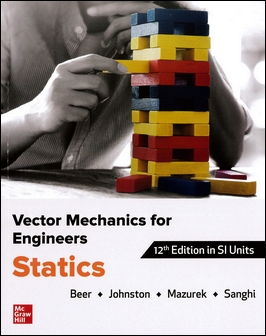書籍分類

Vector Mechanics for Engineers: Statics 12/e
作者:Ferdinand Beer, Russell Johnston, David Mazurek, Sanjeev Sanghi
原價:NT$ 1,350
ISBN:9789813157859
版次:12
年份:2020
出版商:McGraw-Hill
頁數/規格:654頁/平裝彩色
參考網頁:Vector Mechanics for Engineers: Statics 12/e
版次:12
年份:2020
出版商:McGraw-Hill
頁數/規格:654頁/平裝彩色
參考網頁:Vector Mechanics for Engineers: Statics 12/e
內容介紹 本書特色 目錄 作者介紹
- Description
This text helps to develop a student's ability first to analyze problems in a simple and logical manner, and then to apply basic principles to their solutions. A strong conceptual understanding of these basic mechanics principles is essential for successfully solving mechanics problems. Continuing in the spirit of previous editions, this edition provides conceptually accurate and thorough coverage together with a significant refreshment of the exercise sets and online homework problems
A strong conceptual understanding is essential for solving problems successfully. This edition of Vector Mechanics for Engineers helps instructors and students achieve this goal by providing strong understanding and logical analysis for solving problems using SI metrics.
With new concepts presented in a simplified and detailed manner, a number of Advanced or Specialty sections are included. To keep these distinct and optional, they are marked with asterisk so users can choose whether or not to read. The text adopts SMART (Strategy, Modeling, Analysis, Reflect and Think) approach to problem solving. Maintaining its sound and significant pedagogy, approximately 300 homework problem sets are introduced or revised. The book is enhanced by rich online resources for instructors and students in Connect.
分類位置:
理工 > 機械工程 > 靜力學


